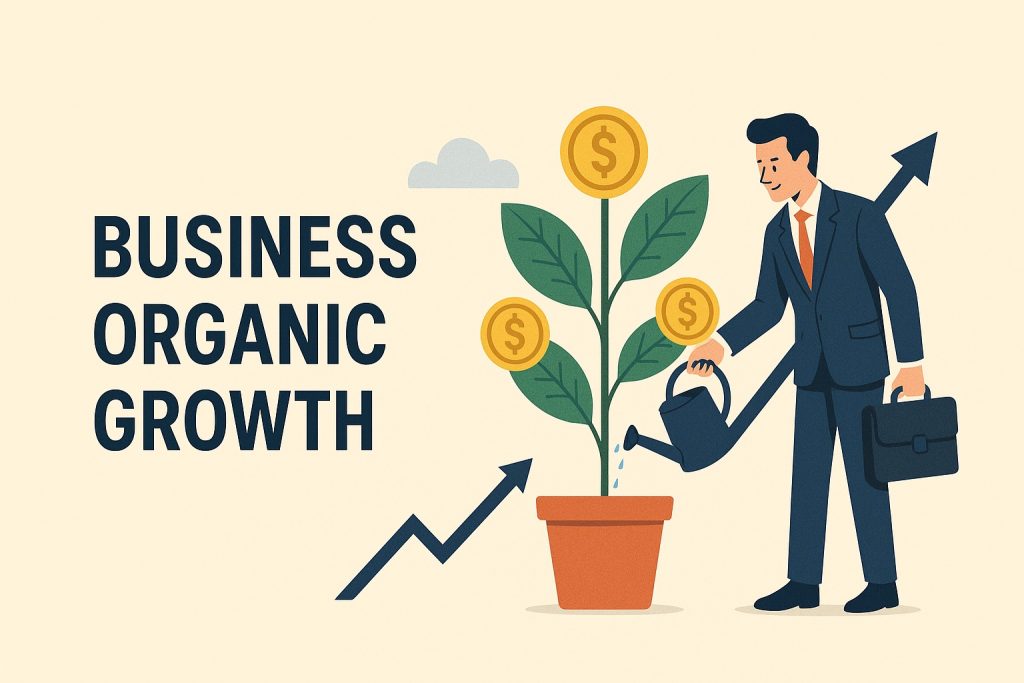Many business leaders chase rapid expansion through acquisitions, mergers, and expensive advertising campaigns. While these inorganic methods can deliver quick results, they often come with high costs and significant risks. There is another, more sustainable path to building a resilient and profitable company: business organic growth. This approach focuses on expanding your business using its own resources, capabilities, and momentum. For instance, keeping up with industry trends in business intelligence and staying aligned with your brand goals are both crucial parts of a successful organic growth strategy. It’s about building from the inside out, creating a strong foundation that can weather economic shifts and foster long-term loyalty.
This comprehensive guide will explore the core principles of business organic growth. We will unpack actionable strategies, from enhancing your product to mastering content marketing, that you can implement to scale your operations sustainably.
You will learn how to leverage your existing strengths, cultivate customer relationships, and create a self-perpetuating cycle of growth that doesn’t rely on massive external investments.
What is Business Organic Growth?
Business organic growth is the process of a company expanding through its internal efforts and resources. Instead of acquiring other companies or securing large rounds of venture capital to fuel expansion, an organically growing business increases its revenue, customer base, and it will help to make market penetration and market share through its own operations. This includes activities like optimizing existing products, entering new markets with current offerings, improving sales processes, and enhancing marketing efforts.

Think of it like a well-tended garden. Instead of buying fully grown plants from a nursery (inorganic growth), you cultivate your garden from seeds. You nurture the soil, provide water and sunlight, and prune where necessary. The result is a robust, healthy ecosystem that grows stronger and more resilient over time. This is the essence of organic growth and it’s deliberate, sustainable, and built on a solid foundation.
Organic Growth vs. Inorganic Growth: Key Differences
Understanding the distinction between organic and inorganic growth is crucial for strategic planning.
| Feature | Organic Growth | Inorganic Growth |
|---|---|---|
| Source | Internal resources (sales, marketing, innovation) | External resources (mergers, acquisitions, joint ventures) |
| Speed | Typically slower and more gradual | Often rapid and immediate |
| Cost | Lower initial investment | High upfront capital required |
| Risk | Lower risk, more controlled | Higher risk, potential for culture clashes, integration issues |
| Integration | Seamless, builds on existing culture | Complex, requires merging different systems and teams |
| Sustainability | High, builds long-term value and capability | Can be less sustainable if integration fails or debt is high |
While inorganic strategies can provide a significant shortcut to scale, organic growth builds institutional knowledge, operational efficiency, and a strong brand identity that is difficult to replicate.
Why Prioritize Business Organic Growth?
Focusing on organic growth offers a multitude of benefits that contribute to a company’s long-term health and stability. It’s not just about saving money; it’s about building a better, more resilient business.
1. Enhanced Profitability and Financial Health
Organic growth is often more profitable. By reinvesting profits back into the business, you expand without taking on significant debt or diluting equity. This leads to stronger balance sheets and better control over your company’s financial destiny. Every new customer acquired through organic means—like a referral or a Google search—typically has a lower Customer Acquisition Cost (CAC) than one gained through a costly ad campaign, directly boosting your profit margins.
2. Sustainable and Controlled Scaling
Growth that is too fast can be just as dangerous as no growth at all. Organic growth allows you to scale at a manageable pace. As your customer base expands, your internal operations, from customer support to logistics, have time to adapt and improve. This controlled scaling prevents the operational bottlenecks and quality decline that can plague companies experiencing explosive, inorganic growth.
3. Stronger Brand Identity and Culture
Growing from within solidifies your company culture of building brand awareness and brand identity. New hires are integrated into an established system, and your brand message evolves consistently. When you acquire another company, you also acquire its culture, which can lead to internal friction and a diluted brand. Organic growth ensures that your company’s values and mission remain at the core of your expansion.
4. Deepened Customer Loyalty
Organic growth strategies are inherently customer-centric. They focus on improving the product, delivering exceptional service, and building a community around your brand. This fosters a loyal customer base that not only returns but also becomes a powerful engine for growth through word-of-mouth marketing and that will increase your customers royalty. A happy customer is your most effective salesperson.
Actionable Strategies for Driving Business Organic Growth
Achieving sustainable organic growth requires a multi-faceted approach. It’s about making incremental improvements across your entire business. Here are eight powerful strategies you can implement.
1. Product and Service Optimization
Your offering is the bedrock of your business. Before you can grow, you must ensure your product or service is not just good, but exceptional.
- Gather Customer Feedback: Actively solicit feedback through surveys, reviews, interviews, and social media listening. What do your customers love? What frustrates them? Use this data to guide your product development roadmap. Tools like Hotjar, SurveyMonkey, and Typeform can be invaluable.
- Iterate and Innovate: Use the feedback to make iterative improvements. This could mean fixing bugs, adding highly requested features, or streamlining the user experience. A commitment to continuous improvement keeps your product relevant and ahead of the competition.
- Expand Your Offering: Look for opportunities to add complementary products or services. If you sell high-end coffee beans, could you also offer brewing equipment or online coffee-tasting classes? This increases the lifetime value (LTV) of your existing customers.
Example: Slack, the communication platform, grew organically by obsessively focusing on its product. They listened to early users, refined features, and created a tool that people genuinely loved to use. Their growth was fueled by teams inviting other teams, creating a viral loop based on product excellence.
2. Master Content Marketing
Content marketing is the engine of modern organic growth. It involves creating and distributing valuable, relevant, and consistent content to attract and retain a clearly defined audience.
- Identify Your Audience’s Pain Points: What questions are your potential customers typing into Google? What problems are they trying to solve? Use tools like AnswerThePublic, Ahrefs, or SEMrush to identify these queries.
- Create High-Value Content: Develop blog posts, guides, videos, podcasts, and webinars that address these pain points. The goal is to become the go-to resource in your niche. If you are a financial advisor, create content on “How to Build a Retirement Plan” or “Beginner’s Guide to Investing.”
- Optimize for Search Engines (SEO): Ensure your content is discoverable. Conduct keyword research to understand what terms your audience uses. Include these keywords naturally in your titles, headings, and body text. Build high-quality backlinks by creating content that other sites want to reference.
- Distribute Your Content: Don’t just publish and pray. Promote your content on social media, in your email newsletter, and on relevant forums like Reddit or Quora.
Example: HubSpot built its entire marketing strategy around inbound marketing. They provide free tools, certifications, and an extensive library of blogs and ebooks covering every marketing and sales topic imaginable. This content attracts millions of visitors, many of whom convert into paying customers.
3. Build a Powerful Email Marketing Funnel
Implementing effective email marketing strategies is crucial for organic business growth. A well-structured funnel not only increases engagement but also drives more conversions from your existing audience. Consider leveraging proven tactics such as personalized email sequences, automated workflows, and A/B testing to optimize performance.
Email remains one of the most effective channels for nurturing leads and driving sales. It’s a direct line to your audience that you own.
- Build Your List: Offer a valuable incentive, known as a lead magnet, in exchange for an email address. This could be an ebook, a checklist, a webinar recording, or a discount code.
- Segment Your Audience: Don’t send the same message to everyone. Segment your list based on demographics, purchase history, or engagement level. A new subscriber should receive a different email sequence than a loyal, repeat customer.
- Nurture Your Leads: Create automated email sequences (drip campaigns) that guide subscribers through the customer journey. A welcome series can introduce your brand, a nurturing series can educate them about your solutions, and an abandoned cart series can recover lost sales.
- Provide Consistent Value: Your emails shouldn’t always be about selling. Share your latest blog posts, offer exclusive tips, and provide value to keep your subscribers engaged and build trust.
4. Leverage Social Media for Community Building
Social media is more than just a promotional tool; it’s a place to build a community and engage directly with your audience.
- Choose the Right Platforms: Don’t try to be everywhere. Focus on the platforms where your target audience is most active. A B2B software company will likely find more success on LinkedIn, while a fashion brand will thrive on Instagram and TikTok.
- Engage, Don’t Just Broadcast: Ask questions, run polls, respond to comments, and share user-generated content. Make your social media profiles a two-way conversation. The goal is to build relationships, not just amass followers.
- Show the Human Side of Your Brand: Share behind-the-scenes content, introduce your team, and talk about your company’s values. People connect with people, not faceless corporations.
Example: The beauty brand Glossier built a billion-dollar company primarily through social media. They engaged with their community, listened to what products they wanted, and featured real customers in their marketing. Their Instagram account became a hub for a dedicated community of fans.
5. Prioritize an Exceptional Customer Experience
In a competitive market, customer experience can be your most significant differentiator. Happy customers not only return but also become vocal advocates for your brand.
- Map the Customer Journey: Understand every touchpoint a customer has with your brand, from their first visit to your website to their post-purchase support interactions. Identify and eliminate points of friction.
- Provide Proactive Support: Don’t wait for customers to complain. Use live chat to offer help on your website, send post-purchase check-in emails, and create a comprehensive knowledge base or FAQ section to answer common questions.
- Empower Your Support Team: Give your customer service representatives the authority to solve problems without escalating every issue. A well-trained and empowered support team can turn a negative experience into a positive one.
Example: Zappos, the online shoe retailer, is legendary for its customer service. They offer free shipping and returns, a 365-day return policy, and their support team is encouraged to spend as much time as needed to help a customer. This commitment to service created a fiercely loyal customer base and fueled their growth through word-of-mouth.
6. Create a Customer Referral Program
Your happiest customers are your most credible marketers. A formal referral program encourages and rewards them for spreading the word.
- Make It Easy: The referral process should be simple and intuitive. Provide customers with a unique link or code they can easily share.
- Offer a Double-Sided Incentive: Reward both the referrer and the new customer. For example, give both a $20 credit on their next purchase. This motivates the referrer to share and the new customer to convert.
- Promote Your Program: Don’t hide your referral program. Promote it on your website, in post-purchase emails, and on social media.
Example: Dropbox’s early growth was famously driven by its referral program. They offered free storage space to both the referrer and the new user. This simple, double-sided incentive was so effective it helped them grow from 100,000 to 4,000,000 users in just 15 months.
7. Strategic Repurposing of Resources
Organic growth is about maximizing the value of your existing assets. This includes your time, your money, and your content.
- Repurpose Content: Don’t let a great piece of content die after one use. Turn a comprehensive blog post into a series of social media posts, an infographic, a video, or a podcast episode. This extends the reach and lifespan of your content creation efforts.
- Optimize Existing Processes: Regularly review your sales, marketing, and operational processes. Where are the inefficiencies? Can you automate repetitive tasks? Small improvements in efficiency can free up resources to be reinvested in growth initiatives.
- Upsell and Cross-sell: It’s easier and cheaper to sell to an existing customer than to acquire a new one. Identify opportunities to upsell customers to a higher-tier plan or cross-sell them complementary products.
8. Data-Driven Decision Making
Organic growth should not be based on guesswork. Use data to inform your strategy and measure your success.
- Track Key Metrics: Monitor key performance indicators (KPIs) relevant to organic growth. These include Customer Lifetime Value (LTV), Customer Acquisition Cost (CAC), churn rate, website traffic, conversion rates, and customer satisfaction scores (like NPS).
- Use Analytics Tools: Leverage tools like Google Analytics, HubSpot, and your CRM to gather and analyze data. Understand which marketing channels are driving the most valuable traffic and which content is resonating most with your audience.
- Test and Optimize: Use A/B testing to optimize your website, landing pages, emails, and ads. Test different headlines, calls-to-action, images, and offers to see what performs best. A culture of continuous optimization is at the heart of sustainable growth.
Advantages of Organic Growth
Embracing organic growth unlocks a range of valuable benefits for businesses focused on long-term success:
- Sustainability: By growing through your own capabilities and resources, your business builds a strong foundation that can endure market fluctuations and industry changes.
- Cost-Effectiveness: Unlike strategies that rely heavily on paid advertising or acquisitions, organic growth capitalizes on internal improvements and word-of-mouth, keeping acquisition costs low.
- Stronger Customer Loyalty: Organic growth centers on authentic engagement and consistently delivering value. This fosters trust and deepens relationships, turning customers into loyal advocates for your brand.
- Enhanced Brand Reputation: Sustainable, organic expansion allows you to maintain a consistent brand message, culture, and values, which elevates your reputation in the market.
- Reduced Risk: Organic approaches are typically less risky than rapid, acquisition-based growth, minimizing potential integration challenges and financial strain.
- Scalability: As your processes, products, and customer experiences are refined internally, your business is better positioned to scale steadily and meet growing demand.
Organic Growth Marketing
Marketing plays a pivotal role in driving organic growth by attracting, engaging, and retaining customers without heavy reliance on paid advertising or acquisitions. By focusing on authentic engagement and value creation, organic growth marketing builds trust and lasting relationships with your target audience.
Key Strategies for Organic Growth Marketing:
- Content-Driven SEO: Consistently publish valuable blog posts, guides, and videos that address your audience’s pain points. For example, an eco-friendly clothing brand might create articles about sustainable fashion trends, positioning itself as an industry leader and attracting search traffic naturally.
- Social Proof and Reviews: Encourage happy customers to leave reviews and share testimonials. Displaying real feedback on your website or social channels strengthens your reputation and influences prospects’ purchasing decisions.
- Community Engagement: Participate in industry forums, host webinars, and create groups on platforms like Facebook or LinkedIn. Engaging with your community not only fosters loyalty but encourages word-of-mouth referrals.
- Organic Social Media Presence: Share behind-the-scenes stories, customer features, tips, and user-generated content to humanize your brand and spark meaningful conversations. Encourage followers to interact, tag friends, or share your posts.
- Influencer Collaboration: Partner with micro-influencers who align with your values. Rather than expensive endorsement deals, focus on authentic relationships that introduce your brand to engaged niche audiences.
Example:
A SaaS startup might leverage organic growth marketing by offering valuable free resources—such as eBooks or industry reports—and encouraging sign-ups for a newsletter. As their authority grows, organic SEO traffic and subscriber referrals steadily increase their user base.
Actionable Tips:
Track which content, channels, and engagement efforts yield the highest conversion rates and double down on winning strategies. Use feedback tools and analytics to continuously refine your messaging for resonance and reach.
The Long Game: Building Your Organic Growth Flywheel
The true power of business organic growth lies in its ability to create a self-reinforcing cycle, often called a flywheel. It works like this:
- You invest in creating an exceptional product and customer experience.
- This leads to happy customers who stick around and have a high LTV.
- You leverage these happy customers through referral programs and positive reviews, attracting new customers at a low cost.
- You create valuable content (blogs, videos) that answers customer questions, attracting more new prospects through SEO and social media.
- The increased revenue from these new and existing customers is reinvested into further improving the product, the customer experience, and content creation.
This cycle creates momentum. Each turn of the flywheel makes the next turn easier. Unlike a paid ad campaign that stops when you stop paying, the organic growth flywheel continues to spin, driving sustainable and profitable expansion.
Building a business through organic growth is a marathon, not a sprint. It requires patience, discipline, and a relentless focus on providing value to your customers. But the reward is a strong, resilient, and profitable company with a loyal customer base and a powerful brand. By implementing these strategies, you can lay the groundwork for long-term success and build a business that not only grows, but endures.


